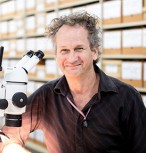DNA reveals the past and future of coral reefs
New DNA techniques are being used to understand how coral reacted to the end of the last ice age in order to better predict how they will cope with current changes to the climate. James Cook Univer

From 2005 to 2022, the main node of the ARC Centre of Excellence for Coral Reef Studies was headquartered at James Cook University in Townsville, Queensland (Australia)








Abstract: The limits to coral growth in terms of depth, latitude and environmental extremes are very topical given climate change and its predicted effects on coral reefs. Using the Queensland Museum’s extensive collection of reef corals we determined a fundamental factor underlying reef coral distributions: the amount of light at depth during winter. This finding was published recently in Science and has implications for some of the “big questions” in coral biology: (a) that many reef corals have limited scope for responding to warming oceans by migrating to higher latitudes and (b) that increasing species richness towards the equator is related to increased winter light for many corals. Paul is also investigating Queensland’s mesophotic coral reefs – those at the limits of coral growth at depths of 30 to 130 m, collaborating with the XL Catlin Seaview Survey (“Google Streetview goes Underwater”) and University of Queensland. These deep reefs are perhaps Queensland’s last great unexplored habitat, covering an area approximately half the size of the “known” Great Barrier Reef, and we are documenting their coral fauna, connectivity with shallow reef corals, how corals thrive at such depths and their potential role as a “deep-reef refuge”. Paul also outlines many of the misconceptions regarding museum research and coral identification and how researchers can benefit from using the Museum collections and taxonomic expertise.
Biography: Paul Muir is a graduate of JCU, completing his Honours degree on asexual reproduction of P. damicornis coral in 1984 and his PhD on marine microbiology and aquaculture in 1991. He recently authored a paper in Science reporting limited scope for latitudinal extension of many corals and causes of a latitudinal gradient in species richness. Working at the Queensland Museum, Townsville, he specializes in taxonomy of the Acropora or staghorn corals and studies mesophotic corals 30-130 m depth. He worked for the previous three years on the Catlin Seaview Survey (known as Google-Streetview goes underwater) as part of the “deep-reef” research team, exploring what is perhaps the last great undocumented Queensland habitat: the deep GBR. Trained as an ROV operator and technical diver he also has interests in programming and robotics.
New DNA techniques are being used to understand how coral reacted to the end of the last ice age in order to better predict how they will cope with current changes to the climate. James Cook Univer
A new study on the effects of climate change in five tropical countries has found fisheries are in more trouble than agriculture, and poor people are in the most danger. Distinguished Profess
James Cook University researchers have found brightly coloured fish are becoming increasingly rare as coral declines, with the phenomenon likely to get worse in the future. Christopher Hemingson, a
Researchers working with stakeholders in the Great Barrier Reef region have come up with ideas on how groups responsible for looking after the reef can operate more effectively when the next bleaching
Abstract: As marine species adapt to climate change, their heat tolerance will likely be under strong selection. Individual variation in heat tolerance and its heritability underpin the potential fo
Abstract: The Reef Ecology Lab in KAUST’s Red Sea Research Center explores many aspects of movement ecology of marine organisms, ranging from adult migrations to intergenerational larval dispersal
Abstract: Macroalgal meadows are a prominent, yet often maligned component of the tropical seascape. Our work at Ningaloo reef in WA demonstrate that canopy forming macroalgae provide habitat for ad
Abstract: Sharks are generally perceived as strong and fearsome animals. With fossils dating back at least 420 million years, sharks are not only majestic top predators but they also outlived dinosa
Abstract: Connectivity plays a vital role in many ecosystems through its effects on fundamental ecological and evolutionary processes. Its consequences for populations and metapopulations have been
Abstract: Evolution of many eukaryotic organisms is affected by interactions with microbes. Microbial symbioses can ultimately reflect host’s diet, habitat range, and even body shape. However, how
Abstract: The past few years have seen unprecedented coral bleaching and mortality on the Great Barrier Reef (GBR) but the consequences of this on biodiversity are not yet known. This talk will expl